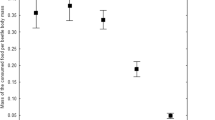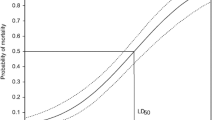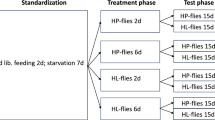Abstract
We examined whether there is a link between feeding behavior and detoxification enzyme activity, which increases over time in proportion to the ingested dose of toxic allelochemicals. We hypothesized that, for insects consuming a toxic but nondeterrent food, consumption would initially decline but then increase after continuous exposure in conjunction with the induction of detoxification enzyme activity. We tested this hypothesis by observing the feeding behavior of fall armyworms (Spodoptera frugiperda) when offered diets containing indole 3-carbinol (I3C), a well-known inducer of detoxification enzymes in this species. The I3C concentrations used were toxic but nondeterrent, thereby avoiding any confounding influence of preingestive responses. The feeding pattern of caterpillars previously unexposed to dietary I3C (i.e. with basal detoxification enzyme activity) was substantially altered when offered I3C-containing diets. Compared with control caterpillars fed I3C-free diets, they exhibited fewer feeding bouts and had a greater proportion of long (> 60 min) non-feeding pauses between bouts. In contrast, the feeding pattern of caterpillars pre-exposed to an I3C diet (i.e. with induced detoxification enzyme activity) did not differ from that of control caterpillars. We conclude that there is a relationship between feeding behavior and detoxification activity in these caterpillars, and propose two postingestive mechanisms that could link these processes.
Similar content being viewed by others
References
Altmann J (1974) Observational study of behaviour: Sampling methods. Behaviour 49: 227–267
Appel HM (1994) The chewing herbivore gut lumen: Physicochemical conditions and their impact on plant nutrients, allelochemicals, and insect pathogens, In: Bernays EA (ed) Insect-plant interactions, Vol. V. CRC Press, Boca Raton, pp 209–223
Blaney WM, Simmonds MSJ (1987) Experience: A modifier of neural and behavioural sensitivity. In: Labeyrie V, Lachaise D (eds) Insects-plants. Dr. W. Junk Publishers, Dordrecht, Netherlands, pp 237–241
Blaney WM, Schoonhoven LM, Simmonds MSJ (1986) Sensitivity variations in insect chemoreceptors; A review. Experientia 42: 13–19
Brattsten LB (1988) Enzymatic adaptation in leaf-feeding insects to host plant allelochemicals. J Chem Ecol 14: 1919–1939
Brattsten LB (1992) Metabolic defenses against plant allelochemicals. In: Rosenthal GA, Berenbaum MR (Eds) Herbivores: Their interactions with secondary plant metabolites. Vol II Ecological and evolutionary processes. Academic Press, New York, pp 176–242
Brattsten LB, Wilkinson CF (1973) Induction of microsomal enzymes in the southern armyworm (Prodenia eridania). Pestic Biochem Physiol 3: 393–407
Brattsten LB, Holyoke CW, Leeper JR, Raffa KF (1986) Insecticide resistance: Challenge to pest management and basic research. Science 231: 1255–1260
Cottee PK (1984) A physiological investigation into the role of secondary plant compounds as feeding deterrents to Locusta migratoria and Schistocerca gregaria Dissertation, Univ Aberdeen
Frazier JL (1992) How animals perceive secondary plant compounds. In: Rosenthal GA, Berenbaum MR (eds) Herbivores: Their interactions with secondary plant metabolites. Vol II. Ecological and evolutionary processes. Academic Press, New York, pp 89–134
Garcia J, Lasiter PS, Bermudez-Rattoni F, Deems DA (1985) A general theory of aversion learning. In: Braveman NS, Bronstein P (eds) Experimental assessments and clinical applications of conditioned food aversions. New York Acad Sci, New York, pp 8–21
Glendinning JI, Slansky F Jr (1994) Interactions of allelochemicals with dietary constituents: Effects on deterrency. Physiol Entomol 19: 173–186
Gould F (1984) Mixed function oxidases and herbivore polyphagy: The devil's advocate position. Ecol Entomol 9: 29–34
Grahame-Smith DG (1986) The multiple causes of vomiting: Is there a common mechanism? In: Davis CJ, Lake-Bakaar GV, Grahame-Smith DG (eds) Nausea and vomiting: Mechanisms and treatment. Springer, New York, pp 1–8
Greene GL, Leppla NC, Dickerson WA (1976) Velvetbean caterpillar: A rearing procedure and artificial medium. J Econ Entomol 69: 487–488
Gunderson CA, Samuelian JH, Evans CK, Brattsten LB (1985) Effects of the mint monoterpene pulegone on Spodoptera eridania (Lepidoptera: Noctuidae). Environ Entomol 14: 859–863
Harley KLS, Thorsteinson AJ (1967) The influence of plant chemicals on the feeding behavior, development, and survival of the two-striped grasshopper, Melanoplus bivittatus (Say), Acrididae: Orthoptera. Can J Zool 45: 305–319
Holyoke CW, Reese JC (1987) Acute insect toxicants from plants. In: Morgan ED, Mandava NB (eds) Handbook of natural pesticides. Vol III: Insect growth regulators, part B. CRC Press, Boca Raton, FL, pp 67–118
Kennedy GG (1984) 2-tridecanone, tomatoes and Heliothis zea: Potential incompatibility of plant antibiosis with insecticidal control. Entomol Exp Appl 35: 305–311
Lee JC, Bernays EA (1990) Food tastes and toxic effects: Associative learning by the phytophagous grasshopper Schistocerca americana (Drury) (Orthoptera: Acrididae). Anim Behav 39: 163–173
Lindroth RL (1991) Differential toxicity of plant allelochemicals to insects: Roles of enzymatic detoxication systems. In: Bernays EA (ed) Insect-plant interactions, Vol III. CRC Press, Boca Raton, pp 1–33
Liu M-Y, Plapp FW Jr (1991) Down-regulation of saxitoxin binding in house flies by pyrethroids and other insecticides. Pestic Biochem Physiol 41: 232–237
Noldus LPJJ (1991) The observer: A software system for collection and analysis for observational data. Behav Res Meth Instr Comp 23: 415–429
Okajima A, Kumagai K, Watanabe N (1989) The involvement of interoceptive chemosensory activity in the nervous regulation of the prothoracic gland in a moth Mamestra brassicae. Zool Sci 6: 859–866
Reese JC, Holyoke CW (1987) Allelochemics affecting insect growth and development. In: Morgan ED, Mandava NB (eds) Handbook of natural pesticides. Vol III: Insect growth regulators, part B. CRC Press, Boca Raton, FL, pp 21–66
Rosenthal GA, Berenbaum MR (1992) Herbivores: Their interaction with secondary plant metabolites. Vol I & II, 2nd Ed. Academic Press, New York
Schoonhoven LM (1982) Biological aspects of antifeedants. Entomol Exp Appl 31: 57–69
Shapiro JP (1989) Xenobiotic absorption and binding by proteins in hemolymph of the weevil Diaprepes abbreviatus. Arch Biochem Physiol 11:65–78
Simmonds MSJ, Blaney WM (1983) Some neurophysiological effects of azadirachtin on lepidopterous larvae and their feeding response. In Schmutterer H, Ascher KRS (eds) Proc Second Internall Neem Conference. GTZ, Eschborn, pp 163–180
Simpson SJ (1990) The pattern of feeding. In: Chapman RF, Joern A (eds) Biology of grasshoppers. John Wiley & Sons Inc, New York, pp 73–103
Simpson SJ, Simpson CL (1990) The mechanisms of nutritional compensation by phytophagous insects. In: Bernays EA (ed) Insectplant interactions, Vol II. CRC Press, Boca Raton, FL, pp 111–160
Slansky Jr F (1993) Nutritional ecology: The fundamental quest for nutrients, In: Stamp NE, Casey TM (eds) Caterpillars: Ecological and evolutionary constraints on foraging. Chapman & Hall, New York, pp 29–91
Snyder MJ, Hsu E-L, Feyereisen R (1993) Induction of cytochrome P-450 activities by nicotine in the tobacco hornworm, Manduca sexta. J Chem Ecol 19: 2903–2916
Snyder MJ, Walding JK, Feyereisen R (1994) Metabolic fate of the allelochemical nicotine in the tobacco hornworm Manduca sexta. Insect Biochem Molec Biol 27: 837–846
Szentesi A, Bernays EA (1984) A study of behavioural habituation to a feeding deterrent in nymphs of Schistocerca gregaria. Physiol Entomol 9: 329–340
Szentesi A, Jermy T (1990) The role of experience in host plant choice by phytophagous insects. In: Bernays EA (ed) Insect-plant interactions, Vol II. CRC Press, Boca Raton, pp 39–74
Teitz HM (1972) An index to the described life histories, early stages and hosts of Macrolepidoptera of the continental United States and Canada. AC Allyn, Sarasota, Florida
Usher BF, Bernays EA, Barbehenn RV (1988) Antifeedant tests with larvae of Pseudaletia unipuncta: Variability of behavioral response. Entomol Exp Appl 48: 203–212
Virtanen AI (1965) Studies in organic sulphur compounds and other labile substances in plants. Phytochemistry 4: 207–228
Wadleigh RW, Yu SJ (1988a) Detoxification of isothiocyanate allelochemicals by glutathione transferase in three lepidopterous species. J Chem Ecol 14: 1279–1288
Wadleigh RW, Yu SJ (1988b) Metabolism of organothiocyanate allelochemical by glutathione transferase in three lepidopterous insects. J Econ Entomol 81: 776–780
Wheeler GS, Slansky F Jr, Yu SJ (1993) Fall armyworm sensitivity to flavone: Limited role of constitutive and induced detoxifying enzyme activity. J Chem Ecol 19: 645–667
Yu SJ (1983) Induction of detoxifying enzymes by allelochemicals and host plants in the fall armyworm. Pestic Biochem Physiol 19: 330–336
Yu SJ (1986) Consequences of induction of foreign compound-metabolizing enzymes in insects, In: Brattsten LB, Ahmad S (eds) Molecular aspects of insect-plant associations. Plenum Publishing Corporation, New York, pp 153–174
Yu SJ (1987) Microsomal oxidation of allelochemicals in a generalist (Spodoptera frugiperda) and semispecialist (Anticarsia gemmetalis) insect. J Chem Ecol 13: 423–436
Yu SJ, Hsu EL (1993) Induction of detoxification enzymes in phytophagous insects: Roles of insecticide synergists, larval age and species. Arch Insect Biochem Physiol 24: 21–32
Author information
Authors and Affiliations
Rights and permissions
About this article
Cite this article
Glendinning, J.I., Slansky, F. Consumption of a toxic food by caterpillars increases with dietary exposure: support for a role of induced detoxification enzymes. J Comp Physiol A 176, 337–345 (1995). https://doi.org/10.1007/BF00219059
Accepted:
Issue Date:
DOI: https://doi.org/10.1007/BF00219059




